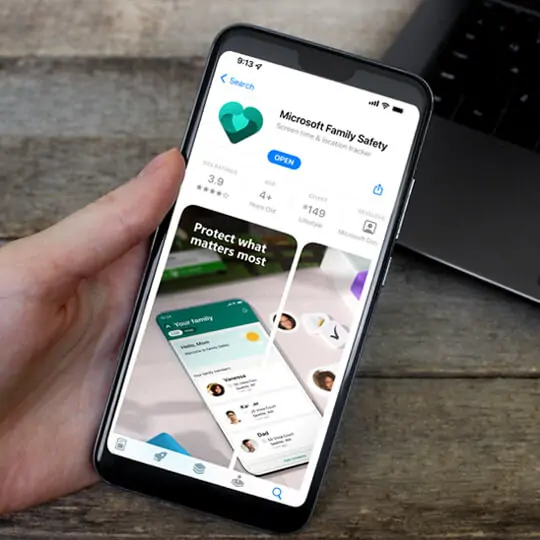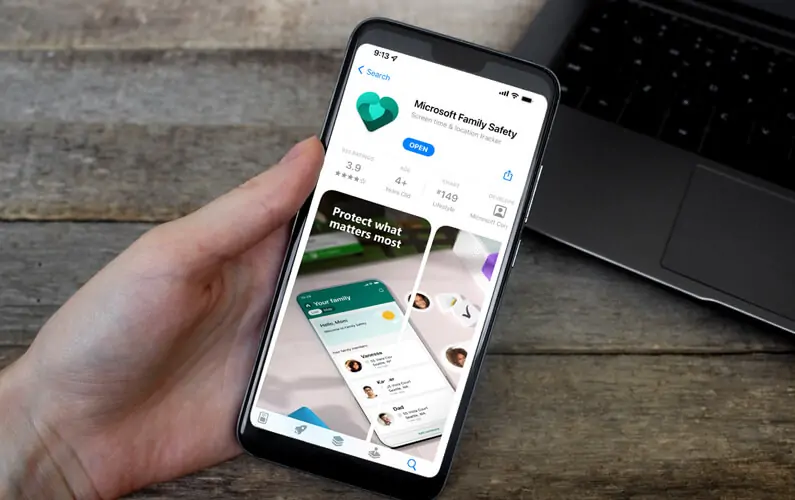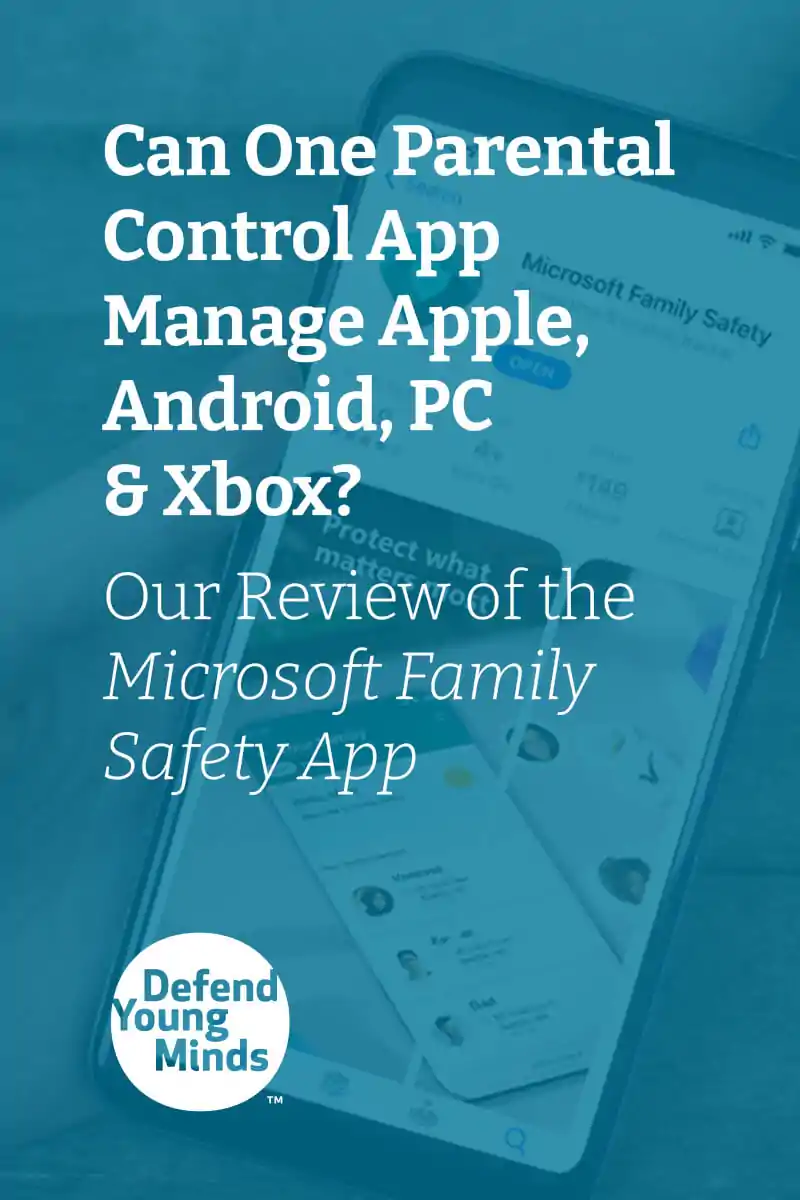

Can One Parental Control App Manage Apple, Android, PC & Xbox? Our Review of the Microsoft Family Safety App
When it comes to managing parental controls for all of your family’s different devices, do you use multiple apps because there’s not one that does everything you need? The Microsoft Family Safety App is designed to solve this problem. But can it really streamline all your parental control needs?

What does the Microsoft Family Safety App do?
The Microsoft Family Safety app combines parental controls for all of your Microsoft devices, primarily Windows computers and Xbox consoles. Some features can also be enabled on Android phones and Apple devices.
Microsoft Family Safety does the basics you’d expect of a parental control app including:
- setting time limits and bedtimes for your child’s devices (either for each device individually or across all of them as a whole),
- reporting which apps your child spent time on,
- providing basic filtering by age category as well as a whitelist and blacklist for custom sites and apps,
- summarizing your child’s web activity (including search terms) on Microsoft Edge browsers,
- managing your child’s Microsoft account balance for purchases through the Xbox store, and
- displaying a GPS location so you can track your children’s location.
Related: Best Phones for Kids! Comparison Guide for Gabb, Pinwheel and Troomi
Pros and Cons of the Microsoft Family Safety App
As with all apps, we found some things we liked about the Microsoft Family Safety app as well as some areas where it’s lacking.
Here’s our pros and cons list:
Pros
We love how Microsoft Family Safety
- Simplifies setting limits. When a family has many devices, kids can hop from one device to another as each runs out of its allotted screen time, ending up spending more time on screens than parents intended. Family Safety solves that problem by allowing you to set one total time budget across Windows, Xbox, Android, and Apple devices. That may not be all your family’s devices, but it sure is close!
- Sends time and app requests right to your phone. When your kids run out of time or need a new app, Family Safety sends that question straight to your phone or email, where you can deal with it in a few clicks. This makes it easier for parents to help kids if they aren’t together.
- Shows web activity. Family Safety shows the websites your child visited and searches your child made. Not a lot of parental controls do this well. Of course, the accuracy of this info depends on your child using the Microsoft Edge browser. Microsoft has blocked many common workaround browsers by default, but you’ll need to keep an eye out for clever kids who know how to get around things. Still, it’s a feature that many parents want, so it’s great that Microsoft has included it.
- Is available for free. There is a paid version with more features, but the free version has many great built-in features.
- Includes location tracking and monitors driving activity. This is a feature in the paid version. If you’re a parent concerned about your teen’s driving habits, installing Microsoft Family Safety on their phone will let you see when they are speeding, stopping too fast, or using their phone while driving. You can also set up alerts to let you know when they arrive at certain locations like school or a friend’s house. The paid version costs $9.99/month or $99.99/year. This is pricey compared to similar apps, but it’s part of the Microsoft 365 subscription, so if you pay for the latest version of Microsoft Office, you should already have access.
Related: How to Set Up Google FAMILY LINK Parental Controls
Cons
Some of the drawbacks to Microsoft Family Safety are the
- Overwhelming number of features. Family Safety has lots of features, probably more than most families use, so it can be overwhelming. If you don’t have kids who drive, the drive tracking features take up a lot of space and can’t be turned off.
- Limited iPhone compatibility. Apple has locked down their devices to not allow third-party filtering. As a result, you can basically only use the drive tracking features on an iPhone, so you’ll still need to use Apple Screen Time to provide other limits.
- Clunky interface. Frankly, the app just isn’t as attractive as competitors like Google Family Link and Apple Screen Time. The screens look corporate and boring. It’s also not as intuitive as other apps we’ve used so setting bedtimes and time limits to multiple days takes some practice. There are layers of menus to get to the most basic features. It’s fine once you get used to it, but never a pleasant experience.
[[CTA]]
How to Set Up Microsoft Family Safety
You can set up Microsoft Family Safety with three simple steps:
- Create a Microsoft Family Group with accounts for all of your family members. Each family member will need a Microsoft log-in, then you’ll link them together as a family. Your kids may already have accounts if they log in to Windows machines or have Xbox Live; otherwise, you can create a free account for them.
- Add devices to your account. How to do this depends on the device, so you’ll want to check out Microsoft’s instructions for the device you want to add.
- Customize your family’s limits. At a minimum, you’ll want to set a time limit and bedtimes, as well as turn on age-appropriate filtering. Then you can build on that by adding whitelisted and blacklisted websites and apps as needed.
Is Microsoft Family Safety the solution to parental controls overwhelm? Not yet, but it’s a step in the right direction of integrating filters and time limits across devices, acknowledging the reality that families have a plethora of devices from different ecosystems. Since it’s free, you should definitely set it up if you own a Windows or Xbox device, and maybe consider adding your Android and Apple devices as well.
But remember that no technology is fool proof. A determined teen can get around parental controls if they want to. That’s why you also need to talk with your kids about online dangers like pornography and screen addiction. Be sure to check out our Brain Defense: Digital Safety course to set your kids up for screen time success!

.png)
.png)
Brain Defense: Digital Safety Curriculum - Family Edition
"Parents are desperate for concepts and language like this to help their children. They would benefit so much from this program - and I think it would spur much needed conversations between parents and children.” --Jenet Erikson, parent







